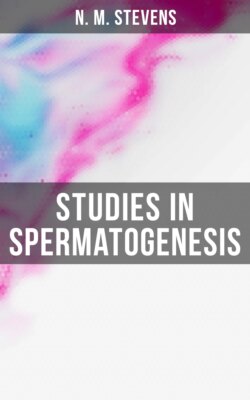Читать книгу Studies in Spermatogenesis - N. M. Stevens - Страница 5
ОглавлениеBy N. M. Stevens.
In connection with the problem of sex determination it has seemed necessary to investigate further the so-called "accessory chromosome," which, according to McClung ('02), may be a sex determinant. This view has been supported by Sutton ('02) in his work on Brachystola magna, but rejected by Miss Wallace ('05) for the spider.
The forms selected for study have been taken from several groups of insects, and are all species whose spermatogenesis has not been previously worked out. They are (1) a California termite, Termopsis angusticollis; (2) a California sand-cricket, Stenopelmatus; (3) the croton-bug, Blattella germanica; (4) the common meal-worm, Tenebrio molitor; and (5) one of the aphids, Aphis œnotheræ.
A brief account of a chromatin element resembling the accessory chromosome in Sagitta has been added for comparison. The spermatogenesis of each form will be described in detail, and a general discussion of the results and their relation to the accessory chromosome and sex determination will follow. The spermatogenesis of the aphid has been included in another paper, but a summary of results and a few figures will be given here for reference in the general discussion.
METHODS.
The testes were fixed in various fluids—Flemming's strong solution, Hermann's platino-aceto-osmic, Gilson's mercuro-nitric, Lenhossek's alcoholic sublimate acetic, and corrosive acetic. Flemming's and Hermann's fluids followed by safranin gave good results in most cases. The mercuro-nitric solution and Lenhossek's fluid gave excellent fixation and were preferable to the osmic mixtures when it was desirable to stain the same material with iron-hæmatoxylin, and also with various anilin stains.
Heidenhain's iron-hæmatoxylin, either alone or with orange G or erythrosin, was used more than any other one stain. With osmic fixation safranin gave better results in some cases, because of the abundance of spindle fibers and sphere substance which were stained by hæmatoxylin. The safranin-gentian combination used by Miss Wallace and others in the study of the accessory chromosome did not prove to be especially helpful with these forms. Thionin was found to be a very useful stain for distinguishing between the accessory chromosome and an ordinary nucleolus. Licht-grün was often used in combination with safranin.
